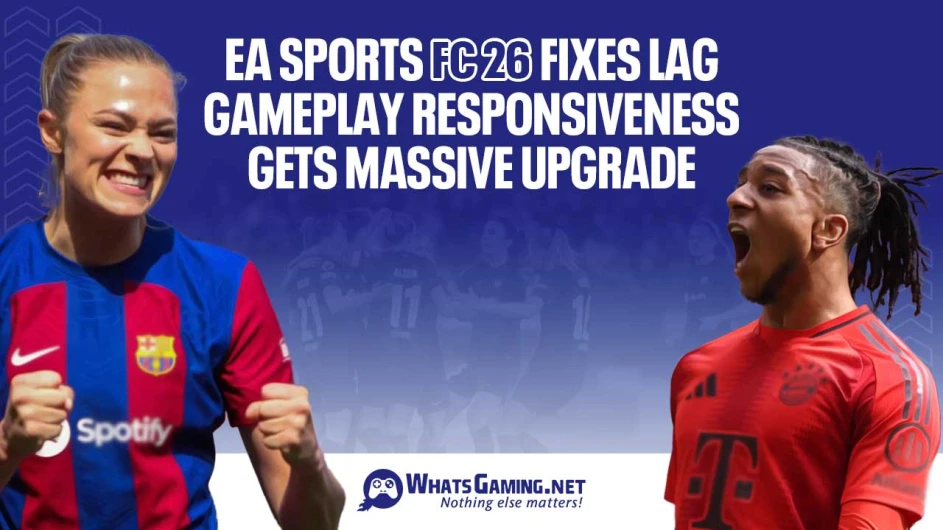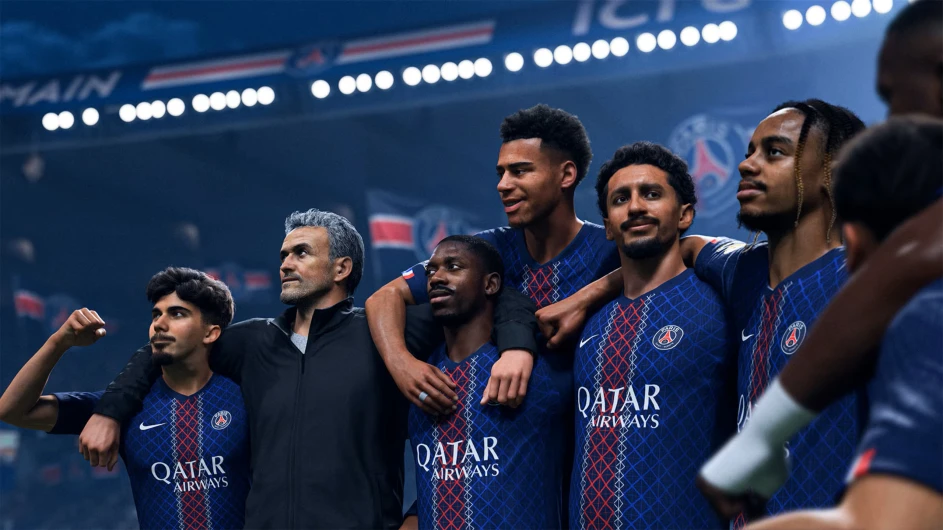
EA SPORTS FC 26 Fixes Lag: Gameplay Responsiveness Gets Massive Upgrade
- Understanding the Root of Gameplay Delay
- Testing Responsiveness With Real Players and Real Setups
- What Players Actually Feel as “Delay”
- Wi-Fi vs Ethernet – Why Wired Wins Every Time
- Bandwidth, Displays, and Hardware Also Play a Role
- Introducing Two Gameplay Styles: Competitive vs Authentic
- FC 26 Fundamentals: Gameplay Responsiveness at the Core
- Hundreds of New Animations and Improved Coverage
- Fixing Animation Bugs and Input Lag Frame by Frame
- Stay Tuned for More in the FC 26 Gameplay Deep Dive
EA SPORTS has officially kicked off a new development initiative with the FC Feedback Hub, offering a transparent and collaborative look into the game's ongoing evolution. This hub serves as a direct line between players and developers, ensuring feedback is both heard and implemented in meaningful ways. The first update focuses on a topic near and dear to every player’s heart: gameplay responsiveness. EA is determined to make FC 26 their most fluid and intuitive football simulation yet.
By launching this hub and emphasizing online responsiveness early in the lifecycle of FC 26, EA is proving their commitment to delivering a better football experience for all players. Whether you're grinding Division Rivals, competing in FC Pro, or enjoying a Career Mode run, gameplay delay is something that can ruin immersion. This initiative represents a positive step in making gameplay more consistent and enjoyable for every FC fan.
Understanding the Root of Gameplay Delay
In simple terms, gameplay delay refers to the gap between when a player presses a button and when the game responds. This delay can originate from various factors such as internet connection quality, ping, display issues, or even how animations are processed in the game engine. When this lag exists, the game feels unresponsive—and for a competitive football title, that's a dealbreaker.
In FC 26, EA is taking these concerns seriously. By focusing on all the components that contribute to delay, both technical and gameplay-related, they aim to give players a more consistent experience. Whether you're online or offline, your actions on the controller should translate instantly into on-screen decisions. That’s the bar EA is trying to reach in this year’s title.
Testing Responsiveness With Real Players and Real Setups
EA SPORTS has been testing gameplay responsiveness for years, with deep internal studies starting as far back as 2019. However, for FC 26, they took things to a new level by partnering with FC Design Council members, FC Pro players, and community representatives. These sessions weren’t limited to labs—they went directly to players' homes and training HQs in Spain and the UK to test the game in real-world conditions.
In addition to in-person testing, EA has conducted global remote testing with players across all regions. They’ve been collecting data on connection quality, responsiveness, and player feedback to guide their improvements. Internally, dedicated teams of hardcore players within EA have also been rigorously stress-testing the responsiveness system. This data has helped pinpoint the tiniest issues, even those that happen within a single frame.
What Players Actually Feel as “Delay”
One of the most important takeaways from EA’s deep testing is just how sensitive players are to even minor input lag. Delays as small as a single frame—around 16 milliseconds can drastically change how the game feels. And interestingly, delay is not exclusive to online play; it can also be felt offline due to how animations and inputs are handled.
Offline delay is often caused by animation choices, input processing lags, or system bugs. Meanwhile, online delay is more likely to stem from factors like poor ping, Wi-Fi instability, and server inconsistencies. The dev team learned that these experiences vary from player to player, which means solutions need to be flexible and wide-reaching.
Wi-Fi vs Ethernet – Why Wired Wins Every Time
A surprising stat shared by EA is that over 50% of FC players still use Wi-Fi when playing online. Unfortunately, Wi-Fi connections are far more prone to jitter, packet loss, and sudden lag spikes. Even the best Wi-Fi setups can introduce instability. That’s why EA strongly recommends switching to a wired Ethernet connection whenever possible to minimize latency and maximize responsiveness.
Having a low ping is also crucial. While it might seem logical that being geographically close to an EA server guarantees low ping, that isn’t always true. Internet routing practices by service providers can impact latency. So, even if you live near a data center, your ping could still be high due to how traffic is handled. EA says they're continuously working with ISPs and server providers to improve routing and ping quality across the globe.
Bandwidth, Displays, and Hardware Also Play a Role
Another often-overlooked cause of gameplay delay is low bandwidth. If your home network is under stress—say, from Netflix streaming or cloud backups—it can significantly affect your game performance. FC 26 encourages players to monitor background network activity and use the Connection Quality Report, a tool that helps you analyze how your network impacts gameplay.
Then there’s the matter of displays. Playing on a TV without Game Mode can add 20–100 milliseconds of delay, which is enough to feel sluggish. EA recommends using Game Mode or investing in a high-refresh-rate gaming monitor for optimal results. Even HDMI cables and external capture cards can introduce minor input lag. In short, your hardware setup is just as important as your connection when it comes to gameplay feel.
Introducing Two Gameplay Styles: Competitive vs Authentic
For FC 26, EA is introducing two distinct gameplay types: Competitive and Authentic. This decision is based on player feedback, which revealed that users want both a responsive, fast-paced experience and a more realistic, thoughtful one. Instead of forcing both into a single model, EA has separated them to better suit different player motivations.
Competitive gameplay will power online modes like Ultimate Team and Clubs, offering consistent, low-latency responsiveness. Meanwhile, Authentic Gameplay is tailored for modes like Career Mode, where realism and true-to-life pacing take priority. By separating these systems, FC 26 promises to cater better to both casual fans and hardcore players alike, delivering satisfaction regardless of how you play.
FC 26 Fundamentals: Gameplay Responsiveness at the Core
The FC 26 reveal trailer teased several gameplay fundamentals designed to drastically improve responsiveness. One of the biggest improvements revolves around how animations are handled. In previous years, animation variability sometimes created unexpected delays. For FC 26, EA is balancing that realism with more consistent input responses.
Animations are now more deeply integrated into the responsiveness system. Player movement, ball control, and tackles will trigger smoother and more intuitive reactions. More branching paths and quicker transitions are being implemented, so players can feel in control even in complex gameplay moments. It’s about offering visual authenticity without compromising input speed.
Hundreds of New Animations and Improved Coverage
One key to smoother gameplay in FC 26 is the addition of hundreds of new animations. These additions help fill gaps in gameplay situations where previous titles had limited animation options. This means fewer moments where your player feels like they’re waiting to “load” into an animation.
By expanding the animation pool and optimizing when and how they trigger, FC 26 players will experience more natural and timely responses. EA has also reassured players that this won’t impact performance strict backend checks ensure that all these additions still allow the game to run smoothly across all platforms.
Fixing Animation Bugs and Input Lag Frame by Frame
The animation system, one of the most complex parts of any football simulation, is getting a much-needed cleanup in FC 26. EA has resolved dozens of bugs related to improper animation choices, such as players curving unnecessarily toward the ball or taking a wrong-footed shot, which introduces unnecessary delays.
Additionally, EA has fine-tuned the input processing system, shaving off precious milliseconds from command-to-action time. For specific cases like first-time shots or passes, they’ve reduced the delay by one frame, which might seem small, but in competitive gameplay, it’s massive. Combine that with improved visual cues like faster player-switch indicators, and FC 26 becomes the most responsive title yet.

Stay Tuned for More in the FC 26 Gameplay Deep Dive
While this Pitch Notes article already unveils a lot, there’s even more coming. EA has promised to share deeper technical breakdowns and gameplay demonstrations in their upcoming FC 26 Gameplay Deep Dive, set to release on July 22. This will showcase the responsiveness improvements in action and explain the work done behind the scenes to deliver a smoother footballing experience.
With all the changes, FC 26 is shaping up to be a breakthrough title in terms of input responsiveness and connection stability. Whether you're playing competitively or immersing yourself in a realistic Career Mode, smoother gameplay is on the horizon. Stay tuned as we learn more about how EA is taking your feedback and turning it into meaningful upgrades.
We will share more updates on FC 26 in separate articles. If you found this information helpful or would like to learn more, please be sure to explore the other articles on our site.
Will eFootball 2026 Finally Overtake FC26? New Updates, Licenses, and Big Rumors






